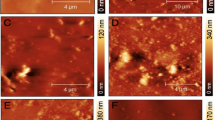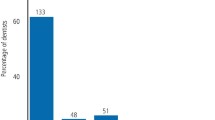Key Points
-
Highlights the importance of the appropriate selection of detergents for instrument cleaning in optimizing the efficacy of the cleaning process, staff safety and cost-effectiveness.
-
Discusses the challenges in obtaining detailed information to support procurement decisions for detergents.
-
Emphasizes that benchmarking for detergent efficacy would be beneficial to general dental practitioners.
Abstract
Aim To review physico-chemical data supplied for commercially available detergents marketed for manual and/or ultrasonic cleansing of reusable dental instruments.
Method Manufacturers/suppliers of commercially available detergents for manual or ultrasonic cleaning of dental instruments within primary dental care were invited to supply product information. A structured questionnaire requested details on a range of physical and chemical properties for each detergent.
Results Seventeen detergent manufacturers/suppliers, encompassing 31 commercially available detergents were identified. Ten of the 17 manufacturers provided information on 23 (74%) of the detergent formulations. Nine detergents were of neutral pH, ten mild alkalis (pH 7.5-10.5) and four strong alkalis (pH >10.5). Sixteen detergents were recommended for ultrasonic and manual cleaning, four stated ultrasonic use and three manual only. Ten detergents cited enzymatic activity as their main mode of action, but only six manufacturers provided detailed information. Four detergents recommended by manufacturers as suitable for manual washing had a strong alkaline pH (>10.5), presenting chemical hazards to users. Two strong alkaline detergents did not warn users of potential adverse effects of such alkaline solutions (corrosion) upon aluminium containing instruments. Only one detergent had investigated the potential toxicity of detergent residuals remaining on instruments after reprocessing.
Conclusion It has proven challenging to collate physico-chemical data on detergents suitable for use in manual and/or ultrasonic cleaning of dental instruments in general dental practice. Standardisation of information on the nature and efficacy of dental detergents in a readily accessible form would be beneficial to dental practice.
Similar content being viewed by others
Log in or create a free account to read this content
Gain free access to this article, as well as selected content from this journal and more on nature.com
or
References
Department of Health. Economics, Statistics and Operational Research Division. Assessing the risk of vCJD transmission via surgery: an interim review. Department of Health. London: The Stationery Office, 2005.
Hervé R, Secker T J, Keevil C W . Current risk of iatrogenic Creutzfeld-Jakob disease in the UK: efficacy of available cleaning chemistries and reusability of neurosurgical instruments. J Hosp Infect 2010; 75: 309–313.
Lipscomb I P, Pinchin H, Collin R, Keevil C W . Effect of drying time, ambient temperature and pre-soaks on prion-infected tissue contamination levels on surgical stainless steel: concerns over prolonged transportation of instruments from theatre to central sterile service departments. J Hosp Infect 2007; 65: 72–77.
Taylor D M . Preventing accidental transmission of human transmissible spongifomencephalopathies. Br Med Bull 2003; 66: 293–303.
Flechsig E, Hegyi I, Enari M, Schwarz P, Collinge J, Weissmann C . Transmission of scrapie by steel-surface-bound prions. Mol Med 2001; 7: 679–684.
Zobeley E, Flechsig E, Cozzio A, Enari M, Weissmann C . Infectivity of scrapie prions bound to a stainless steel surface. Mol Med 1999; 5: 240–243.
Bernoulli C, Siegfried J, Baumgartner G et al. Danger of accidental person-to-person transmission of Creutzfeld-Jakob disease by surgery. Lancet 1977; 1: 478–479.
Peretz D, Supattapone S, Giles K et al. Inactivation of prions by acidic sodium dodecyl sulfate. J Virol 2006; 80: 322–331.
Starace C A . Detergent enzymes: developments during the last decade. J Am Oil Chem Soc 1981; 58: 165–170.
NHS Estates. A guide to decontamination of reusable surgical instruments. London: NHS Estates, 2003.
Holah J T, Thorpe R H . Cleanability in relation to bacterial retention on unused and abraded domestic sink materials. J Appl Microbiol 1990; 69: 599–608.
Smith A J, Bagg J, Hurrell D, McHugh S . Sterilization of re-usable instruments in general dental practice. Br Dent J 2007; 27: 203.
Molinari J A, Harte J A . Cottone's practical infection control in dentistry. 3rd ed. Philadelphia: Lippincott Williams & Wilkins, 2009.
Bagg J, Smith A J, Hurrell D, McHugh D, Irvine G . Pre-sterilization cleaning of re-usable instruments in general dental practice. Br Dent J 2007; 12: 202.
Department of Health. The dental national decontamination survey 2010. London: Department of Health, 2010.
Zühlsdorf B, Emmirch M, Floss H, Martiny H . Cleaning efficacy of nine different cleaners in a washer-disinfector designed for flexible endoscopes. J Hosp Infect 2002; 52: 206–211.
Wasek S . 11 Common endoscope handling mistakes. Outpatient Surgery Magazine 2003; 5: 52–59.
Tomlinson A, Carnali J . A review of key ingredients used in auto-dishwashing formulations past and present and the physico-chemical processes they facilitate. In Johansson I, Somasundaran P (eds). Hand book for cleaning/decontamination of surfaces. 1st ed. pp. 197–255. Sweden: Elsevier B. V., 2007.
Perkins W . Surfactants: A primer. America's Textiles Int 1998; 8: 57.
Hollingsworth M W . Role of detergent builders in fabric washing formulations. J Am Oil Chem Soc 1978; 55: 49–51.
Nagarajan M K, Paine H L . Water hardness control by detergent builders. J Am Oil Chem Soc 1984; 61: 1,475–1,478.
Camper A K, Hayes J T, Sturman P J, Jones W L, Cunningham A B . Effects of motility and adsorption rate coefficient on transport of bacteria through saturated porous media. Appl Environ Microbiol 1993; 59: 3,455–3,462.
Changa D M . The binding of free calcium ions in aqueous solution using chelating agents, phosphates and poly(acrylic acid). J Am Oil Chem Soc 1983; 60: 618–622.
Gibson H, Taylor J H, Hall K E, Holah J T . Effectiveness of cleaning techniques used in the food industry in terms of the removal of bacterial biofilms. J Appl Microbiol 1999; 87: 41–48.
Hutchisson B, LeBlanc C . The truth and consequences of enzymatic detergents. Gastroenterol Nurs 2005; 28: 372–376.
Lawson V A, Stewart J D, Masters C L . Enzymatic detergent treatment protocol that reduces protease-resistant prion protein load and infectivity from surgical-steel monofilaments contaminated with a human-derived prion strain. J Gen Virol 2007; 88: 2,905–2,914.
Jackson G S, McKintosh E, Flechsig E et al. An enzyme-detergent method for effective prion decontamination of surgical steel. J Gen Virol 2005; 86: 869–878.
Yan Z X, Stitz L, Heeg P, Pfaff E, Roth K . Infectivity of prion protein bound to stainless steel wires: a model for testing decontamination procedures for transmissible spongiform encephalopathies. Infect Control Hosp Epidemiol 2004; 25: 280–283.
National Health Service Scotland. Scottish Health Technical Memorandum 2030. Scotland: NHS, 2001.
Prior, Fernie K, Renfrew A, Heneaghan G . Alcoholic fixation of blood to surgical instruments—a possible factor in the surgical transmission of CJD? J Hosp Infect 2004; 58: 78–80.
Scottish Dental Clinical Effectiveness Programme. Decontamination into practice: part 1 – cleaning of dental instruments. Scotland: SDCEP, 2007.
Scottish Dental Clinical Effectiveness Programme. Decontamination into practice: part 2 – sterilization of dental instruments. Scotland: SDCEP, 2007.
International Organization for Standardization. Washer-disinfectors – part 1: general requirements, terms and definitions and tests. BS EN ISO 2006; 15: 883–881.
International Organization for Standardization. Biological evaluation of medical devices - Part 17: Establishment of allowable limits for leachable substances. ISO 10993-17: 2002
Adisesh A, Murphy E, Barber C M, Ayres J G . Occupational asthma and rhinitis due to detergent enzymes in healthcare. Occup Med 2011; 61: 364–369.
Acknowledgements
Many thanks to G. Irvine and A. Conacher for their contributions to format and questionnaire design.
Author information
Authors and Affiliations
Corresponding author
Additional information
Refereed paper
Rights and permissions
About this article
Cite this article
Calvert, G., Murray, C., Smith, A. et al. Availability of manufacturers' information on efficacy and compatibility of detergents used for cleaning dental instruments. Br Dent J 212, E16 (2012). https://doi.org/10.1038/sj.bdj.2012.419
Accepted:
Published:
Issue date:
DOI: https://doi.org/10.1038/sj.bdj.2012.419
This article is cited by
-
Assessing the efficacy and cost of detergents used in a primary care automated washer disinfector
British Dental Journal (2018)
-
Summary of: Availability of manufacturers' information on efficacy and compatibility of detergents used for cleaning dental instruments
British Dental Journal (2012)



